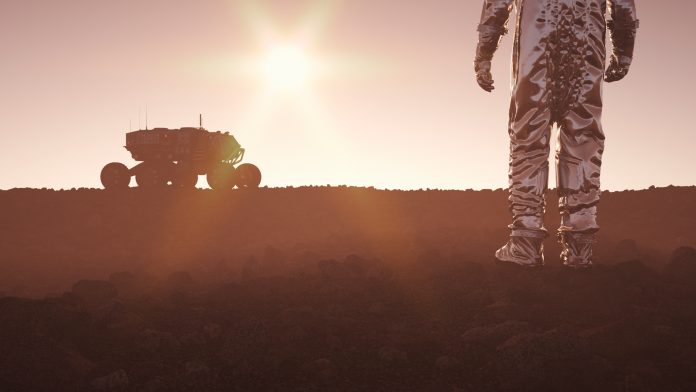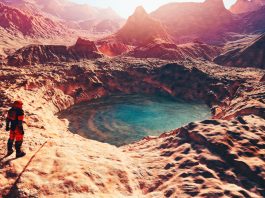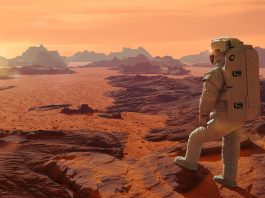A team of UK scientists are assisting NASA with a mission that will facilitate preparation for humanity’s next gigantic leap – sending astronauts to Mars.
A group from The Open University and RAL Space are collaborating with the European Space Agency (ESA) and NASA to investigate the occurrence and behaviour of water on the Moon.
The UK based team, led by The Open University’s Dr Simeon Barber, have created an advanced analytical instrument known as the Exospheric Mass Spectrometer (EMS) under a contract managed by ESA.
Exospheric Mass Spectrometer
The EMS has been built as one of several ESA contributions to forthcoming international lunar missions and expands on the expertise and legacy developed for the Rosetta Philae (Ptolemy) and Luna-27 (PROSPECT) missions.
Combined with hardware provided by NASA’s Goddard Space Flight Center in Greenbelt, it establishes the Peregrine Ion Trap Mass Spectrometer (PITMS) instrument, which will be delivered to NASA today (6 July 2021).
The PITMS instrument
This novel tool will take measurements of the water and other molecules in the very thin atmosphere of the Moon throughout a lunar day, investigating the emergent hypothesis of a lunar ‘water cycle’. As well as this, the instrument will demonstrate some of the detection technology that will be utilised by the Open University on successive missions.
PITMS was formed within a short timeframe, utilising a fast-track development approach that combined high proficiency development with a cautious risk management methodology.
The PITMS instrument is led by Dr Barbara Cohen at NASA’s Goddard Space Flight Centre and will be sent to the Moon later on by Astrobotic, one of the corporations under contract for NASA’s Commercial Lunar Payload Services (CLPS) initiative.
Artemis Generation
Commercial companies will provide dozens of innovative tools and technology experiments to the Moon through the duration of NASA’s Artemis program. Artemis missions consist of both robotic and human exploration on and around the Moon that will prepare humanity for sending astronauts to Mars.
The Artemis program is notable for its commercial and international partnerships, such as ESA, and its objective is to produce the first long-term presence on the Moon. The ability to comprehend available resources such as water on the Moon and learning how to utilise these as provisions for drinking water or rocket propellant may be able to decrease mission costs and facilitate human exploration further into our solar system, such as Mars.
The development of the PITMS instrument is a significant breakthrough in delivering the next generation of tools that will allow Artemis to deliver its ambitious programme of science and exploration.
Astronauts to the moon, to Mars and beyond
Barber commented: “Finding useful materials in space, and using them as supplies for onward journeys, is a simple concept with huge potential benefits. 50 years after humans walked on the Moon, we are limited to 6 astronauts orbiting 300 km above Earth in the International Space Station. All their supplies have to be launched by rocket through Earth’s gravity field. If we can build new bases in lunar orbit or on the Moon’s surface, supplied by materials we find and harvest locally, we can escape from the clutches of Earth’s gravity and explore deeper into our solar system.
“PITMS will study how water and other molecules behave during the warm lunar daytime near a lunar lander. We will obtain ground ground–truth measurements to fill in the detail of the broader view we already have from remote measurements by orbiters. And then we will complete the picture using similar instruments on future landers near the cold lunar poles, where these molecules may have accumulated over billions of years to form a treasure trove of scientifically and practically valuable resources.”
Chris Howe, Production and Software Group Leader at the Science and Technology Facilities Council’s RAL Space, explained: “We have landed a similar instrument on a comet as part of ESA’s Rosetta mission, but nothing has been as challenging as developing an instrument against the backdrop of the pandemic. To have designed, built and tested a proto-flight lunar instrument in just 18 months has been a huge achievement for RAL Space and the OU. Now we look forward to discovering more about the lunar water cycle and playing our part in furthering human exploration of the solar system.”
Chris Castelli, director of programmes at the UK Space Agency, added: “Through the Artemis Accords, the UK plays an essential role in international space missions, building on our existing strengths in communications, robotics and satellites to further our understanding of the universe. If we want to travel extensively in space, we will need to make or find the things, like water, which we require to support life. So this collaboration between the Open University and NASA is crucial in helping us pave the way for the next stages of humankind’s journey into sustainable space exploration.”
Dr Roland Trautner, ESA project lead, concluded: “The flight of ESA’s Exospheric Mass Spectrometer (EMS) as part of PITMS on the first NASA CLPS mission is an exciting opportunity to test our latest environmental monitoring technology for planetary environments. Instruments like EMS will be a key tool to monitor the impact of human activities on the lunar environment. Lunar landers and rovers modify the lunar exosphere at least locally, and monitoring these changes allows us to improve our science and learn how to protect the environment on planetary bodies.”









